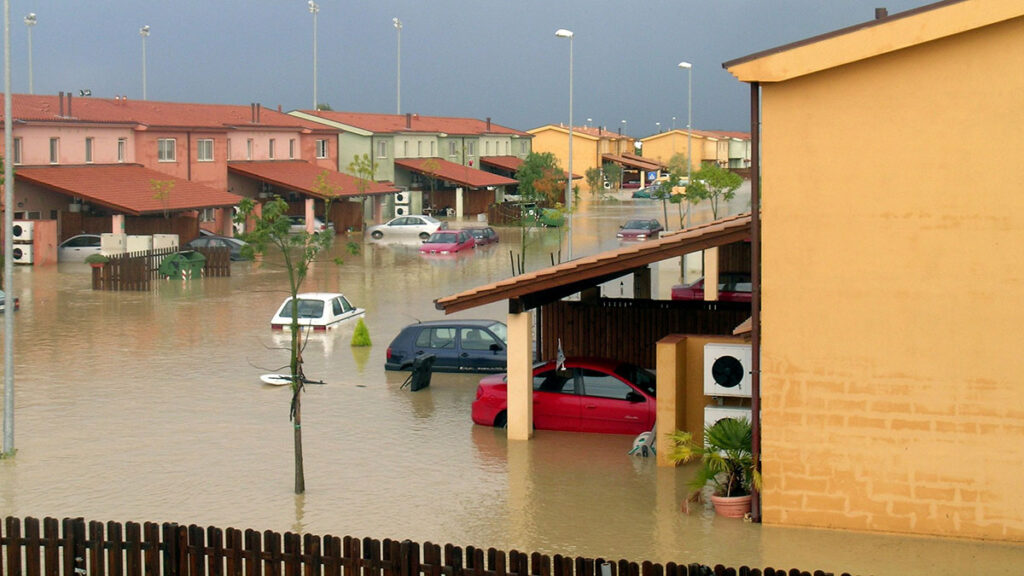
When a crisis hits, do you have water filters to use at home? Domestic water filters are used for many reasons, prepping being just one of them.
Having a filtration/purification system for the home will extend your personal preparedness level dramatically. You could filter floodwaters, hit the stream out back, or just filter water from a puddle in the yard. You could even start looking at your swimming pool as a gigantic source of potable water. Just run it through the filter!
For our purposes, “water filters to use at home during a crisis” means a filter that will produce enough potable water for a small family. These may be designated domestic water filters or filters designed for the backcountry use or bugging out that can double for at-home or “bug in” purposes.
How to Choose Water Filters to Use at Home
When I started writing about prepping years ago there were far fewer “prepper” products on the market. Now the market is flooded. I get daily emails from manufacturers (most from China) trying to push their latest gadget as the next greatest thing that all survivalists need.
Water filters are no different. What was once limited to Berkey products and portable hiking filters has expanded to include countless iterations of each. We now have filter pitchers, so called “straw” filters, etc. The list goes on.
Long gone are the days of just throwing a few iodine tablets into a water bottle, waiting a five minutes, and chugging back lousy-tasting water – floaties and all!
So how do you sort through the countless filters? By starting with an assessment of what you need.
Daily Use?
Nearly 63 million Americans are exposed to unsafe drinking water – that’s about 1/5th of the entire United States! There have been high levels of radium found in Wisconsin groundwater and in Texas.
These aren’t just rural wells, mind you. It’s happening in urban areas as well. The high levels of lead in Flint, Michigan water is but one example. Resident complaints about the water were ignored or dismissed by government officials for years leading to a full-on crisis as the levels kept getting worse.
While this article focuses on domestic water filters for use during a crisis, it’s not unreasonable to want a filter for everyday use given the prevalence of poor quality drinking water. That same EPA report that found 63 million Americans at risk of poor water determined that “six decades of industrial dumping, farming pollution, and water plant and distribution pipe deterioration have taken a toll on local water systems.”
Common sources of these contaminants include:
Industry and agriculture. Organic solvents, petroleum products, and heavy metals from disposal sites or storage facilities can migrate into aquifers. Pesticides and fertilizers can be carried into lakes and streams by rainfall runoff or snowmelt, or can percolate into aquifers.
Human and animal waste. Human wastes from sewage and septic systems can carry harmful microbes into drinking water sources, as can wastes from animal feedlots and wildlife. Major contaminants include Giardia, Cryptosporidium, and E. coli.
Treatment and distribution. While treatment can remove many contaminants, it can also leave behind byproducts (such as trihalomethanes) that may themselves be harmful. Water can also become contaminated after it enters the distribution system, from a breach in the piping system or from corrosion of plumbing materials made from lead or copper.
Natural sources. Some ground water is unsuitable for drinking because the local underground conditions include high levels of certain contaminants. For example, as ground water travels through rock and soil, it can pick up naturally occurring arsenic, other heavy metals, or radionuclides.
https://www.epa.gov/report-environment/drinking-water
Contaminants in drinking water include arsenic from bedrock, factory chemicals, and fecal matter from farming. Yum!
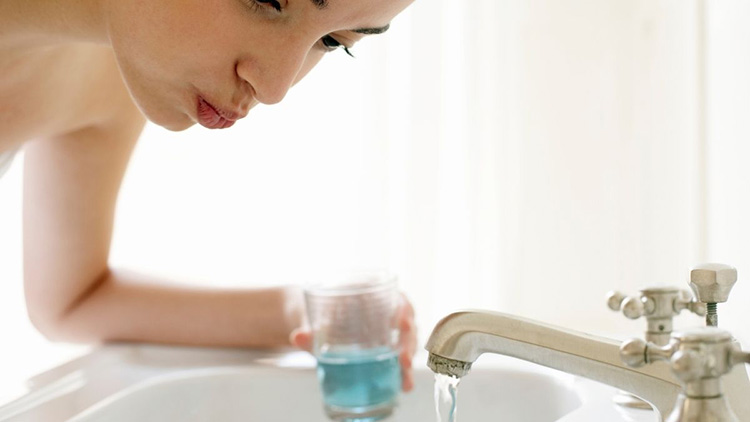
And that’s not even counting lead contamination and bacteria. Poor drinking water of this type can cause cancer, gastrointestinal problems, and developmental delays in children. Further, 73% of the US population on community water systems are drinking fluoridated water. Some people think fluoride in water is a great thing. Others disagree.
If you are concerned about your drinking water under normal circumstances, you may want a water filter that you can use for daily use and have double as a filter in a crisis. This would lead you to a different filter than one made for the backcountry that can double as an at-home filter during a crisis.
Filter or Purifier?
People often use “water filter” and “water purifier” interchangeably, but they’re not the same thing. Do you want a water filter or a water purifier?
The difference is in the level of protection. A filter will remove the most common waterborne protozoa and bacteria that account for the most prevalent problems found in drinking water. In contrast, a purifier removes all of those plus viruses.
A good water filter will serve the needs of most preppers.
You might think that you should just go for full protection then, but depending on your situation, a purifier could be overkill. A simple, quality filter will solve most problems you’d encounter with contaminated drinking water. However, if you live in an urban center, it may be advantageous to have a purifier.
Why? Viruses are transferred from human to human primarily through fecal matter (think Norovirus and Hepatitis A). So, when public water systems are compromised due to a natural disaster or other crisis, it’s not uncommon to have waste water mixing with drinking water. In rural areas with fewer people and more people using wells, this is less of a problem.
Take the popular Sawyer Mini as an example. It’s a great all-purpose filter for most people, but it does not remove viruses. If you live in an urban center or near medical facilities, having an extra layer of protection could add peace of mind.
National Standards
The National Sanitation Foundation (NSF International) is the agency responsible for developing consensus-based national standards for water quality. They have established four standards that you will often see associated with water filters:
- NSF/ANSI 42: Aesthetic Effects – Essentially reducing aesthetic or non-health-related contaminants (useless for our purposes).
- NSF/ANSI 53: Health Effects – Largely for removing chemicals from tap water and includes giardia and cryptosporidium but not bacteria or viruses (not enough for our purposes).
- NSF Protocol P231: Microbiological Water Purifiers – This is the standard level for the removal of disease-causing microorganisms (good enough for most preppers).
- NSF Protocol P248: Military Operations Microbiological Water Purifiers – Filters of this type provide microbiological purification from any fresh water source. It’s the military’s measure for water purification and filters of this type are intended for “individual or squad-size use for emergency or short-term planned missions.” Read that as “more than enough for preppers.”
Note: You can always buy a filter and have a chemical treatment like Aquatabs on hand. Filter your water first then add chemical treatment to purify it.
Your Budget
How much money are you willing to invest in a domestic water filter that you’re only bringing out for a crisis?
I always recommend redundancy in prepping, following the prepping mantra of two is one and one is none. In other words, if you rely on one item, and it breaks, you’re out of luck! Two is better than one and three is better than two.
Redundancy here could be as simple as just boiling water if you can’t filter it, but then you need fuel to heat the water. Reducing extraneous needs as much as possible makes you a better prepper overall and – in the case of fuel – extends your preparedness by reserving what fuel you do have for other needs.
Consider Cost Per Filter
How many gallons of potable water can get from one filter? This is not an easy question to answer, because much of that depends on the quality of water going through it in the first place. You will not get as much clean pond water as you will river water because the pond water is dirtier to begin with.
You can use manufacturer claims on how many gallons a filter can clean but I don’t put much faith in them. Take for example these two claims:
- The little Sawyer Mini filter, designed for backpacking, has a filter small enough to fit in my pocket. The water is drawn via a large plastic syringe. Sawyer claims the Mini “filters up to 100,000 gallons from fresh water sources.”
- The much larger AquaBrick Water Purification System claims to “safely purify up to 700 gallons of contaminated water.”
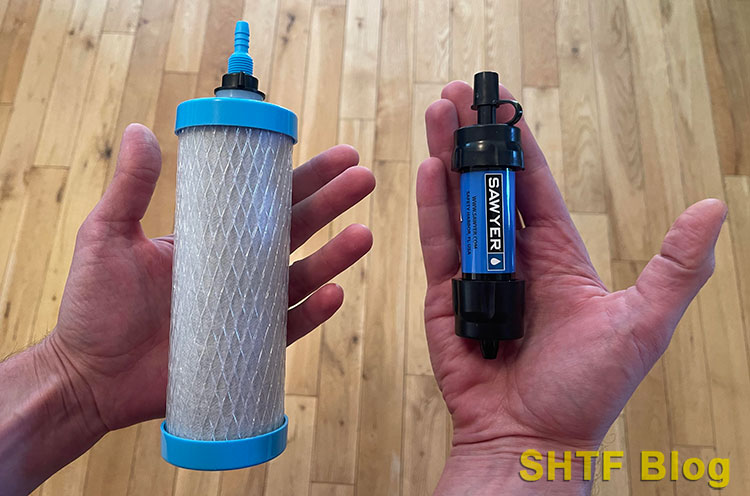
So the Sawyer Mini, which costs about 10% of the AquaBrick system, somehow filters more than 10x the amount of water!?
Doubtful.
I have never tested how many gallons of water the Sawyer Mini will filter, but put this into perspective. An inground pool measuring 12×24′ with an average depth of 5′ will hold almost 11,000 gallons. Sawyer is trying to tell me their little filter will clean about 9 pools worth!?
Of course, these aren’t apples to apples comparisons. The AquaBrick is, after all, a purifier, not just a filter.
But still, even the better built Katadyn Vario filter I use only claims to clean up to 500 gallons per filter cartridge. My guess is the Sawyer would clog or break long before ever reaching 100,000 gallons. You’ll see how outlandish Sawyer’s claim seems when stacked up against the other filters I mention here.
Does that mean the Sawyer Mini is useless? No. It just means be wary of manufacturer claims and use common sense. Bigger filters, or multiple filters in one unit, are going to give you more per-gallon bang for your buck than smaller units.
Based on my experience, the life of a filter depends much more on the quality of the water you’re filtering in the first place.
What matters more to me is how much replacement filters cost and whether they are readily available. The more well-known brands of filters will be easier to buy and could be cheaper in the long run if they receive heavy use.
How Long a Crisis Are You Preparing For?
Preparing for a 2–3-day water disruption is one thing. Preparing for a month or more is something else.
Do you want to be using a pump filter multiple times a day every day for months? If you’re an older prepper with arthritis, that could become a serious problem.
The answer here will depend in part on how much water you’ll need to filter. Water needs vary a lot.
Are you a single person or a family of four? Are you only going to filter drinking water or cooking and dishwater too? Take a look at our water calculator to get an idea of what you might need.
This is where my principle of “stacking” preps can be helpful. If there are competing preps for your money, you can always start at the most basic level to get you prepared to survive a few days to a week.
Then, as you progress, you can add another layer to that with a more advanced filter suitable for longer periods. Now you also have redundancy. “Two is one.”
Versatility
If this is your first and only domestic water filter, and you’re buying it for primarily for emergency purposes, versatility plays a big role. Is the filter portable? If so, it can also double as your bug out backpack filter. Can you use it for bugging out?
On the other hand, if you’re concerned about fluoride or other public water additives, versatility matters less to you. You want at-home convenience.
My Top Choices by Category
I have selected five different filters that I think would serve most preppers well at home in a crisis. I broke them down by category to help you choose what makes sense for you.
| All Purpose | Most Versatile | Domestic System | Tactical Purifier | Purifier/Storage Unit |
|---|---|---|---|---|
| Big Berkey | Katadyn Vario | Epic Smart Shield | MSR Guardian | AquaBrick Water Purification System |
I own three of these filters, so I can speak to those with firsthand experience. The other two (MRS Guardian and Epic Smart Shield) I know enough about to feel qualified to offer some guidance. The brands on both units also speak to their quality. MSR and Epic are both great companies.
All Purpose – Big Berkey
You know the saying “go big or go home?” That’s the Big Berkey. This is the stainless steel standard of at-home water filters. You find them in off-grid cabins, bug out locations, and in urban apartments (think fluoride). I found one in use on Maine’s One Big Sustainable Island.
I received my Big Berkey from Big Berkey Water Filters themselves.
The Big Berkey is by far the most popular model within the Berkey lineup. It’s gravity fed (no pumping water involved), comes with a spigot, is made from stainless steel, and it looks attractive in the home. Replacement filters are readily available from many sellers.

The Big Berkey will remove pathogenic bacteria, viruses, parasites, herbicides, pesticides, Bipshenol-A, radon 222, trihalomethanes, lead, mercury, and more. It will even remove fluoride.
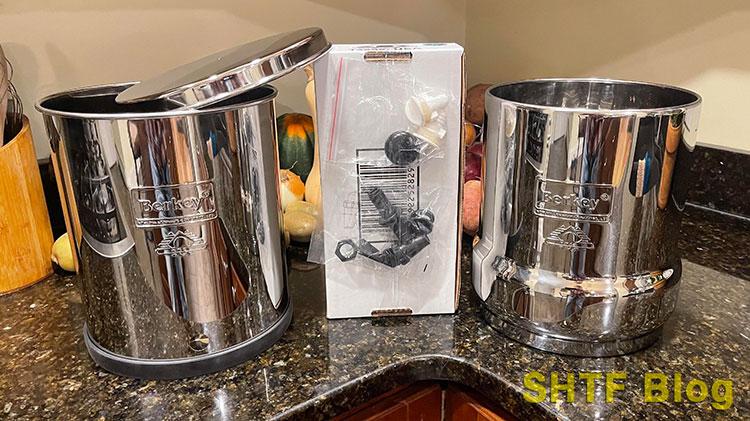

Additional specifications:
- Good for 1-4 people
- Comes with 2 Black Berkeys (the filters themselves)
- Filters approximately 6000 gallons between its 2 filters
- 2.1 gallons storage capacity
- 21″ H x 8.5″ D
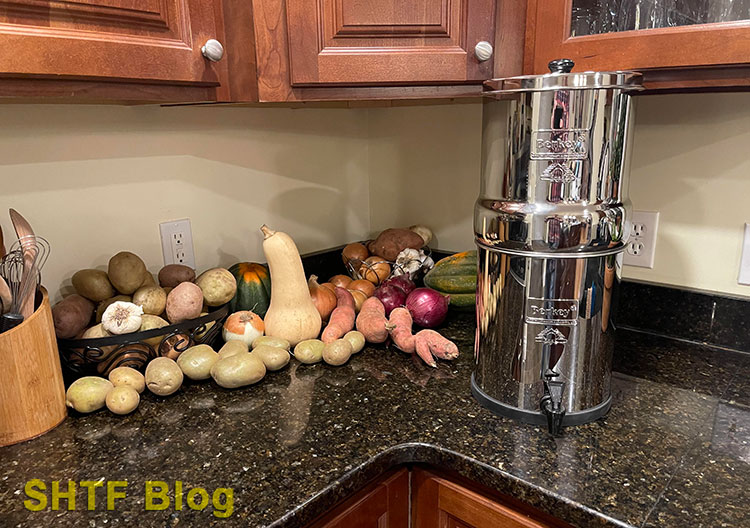
You can see in the above picture that my Big Berkey is too tall to fit under the kitchen cabinets and the spigot sits too low to get a cup under it when sitting on the counter. You can buy a base for Berkey models that will elevate the spigot in relation to the counter, but that makes the unit even taller.
The Big Berkey is a great unit with a great reputation. This is a great choice – if you can find the space for it.
Most Versatile – Katadyn Vario
I use my Katadyn Vario for overnight backpacking trips when carrying all of the water needed is unrealistic due to space and weight. It’s small and relatively lightweight.
This unit is well-built and filters water fast enough that it can easily satisfy the water needs of 3-4 people on a short-term basis. Its versatility makes it well-suited to use in different environments. It’s compact and portable.
The bottom of the unit will screw directly on top of a wide-mouth Nalgene bottle (favored among hikers). Before this article, I don’t think I had ever filled anything other than a Nalgene bottle with it.
No Nalgene? No problem. It also comes with an optional outlet hose so you can discharge clean water into a drinking glass, storage container, or straight into your mouth!
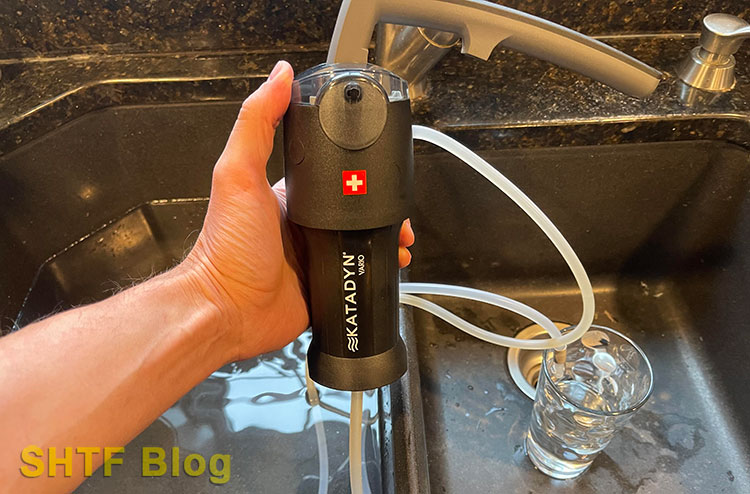
- Dual pumping modes
- Removes particles
- Activated Carbon reduces chemicals
- Suitable for backpacking
- Glass fiber filter
Features of the Katadyn:
- Portable – suitable for emergency at-home use and backpacking.
- Reasonably priced.
- Claims to filter up to 500 gallons per cartridge.
- Conveniently screws on top of wide-mouth Nalgene bottles, making it one of many Nalgene accessories.
- Can be used to fill larger containers.
- Replaceable carbon filters also help improve water taste.
The prepper here will also be happy to know that it comes with many replacement O-rings.
At-Home System – Epic Smart Shield
I like Epic Water Filters. I know the owner personally and I’ve reviewed their products before. They’re based in the U.S. and they stand by their products.
If you want a domestic water filter for everyday use first and foremost, it’s hard to beat the Epic’s Smart Shield system. It installs under your sink and filters water before it comes out of the faucet. Simple, clean, and it removes 99.99% of over 70 known tap water contaminants.
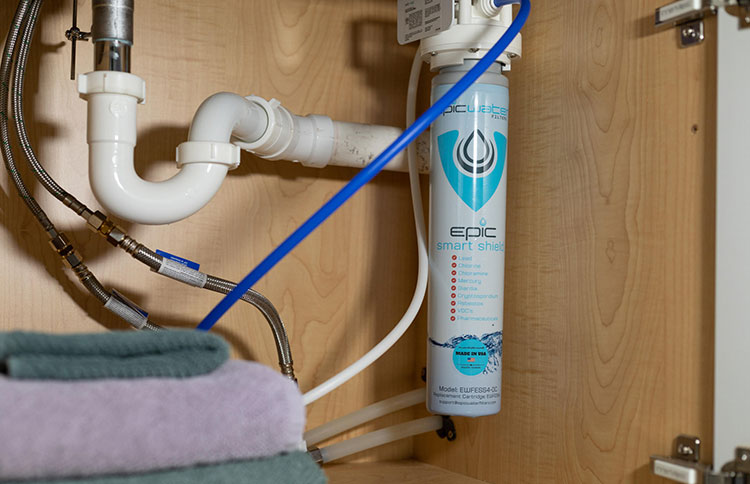
The downside is you need water pressure and (often) electrical power to push water through it. The other choices of domestic water filters do not require either.
Additional features of the Epic Smart Shield:
- Best for everyday use under normal (non crisis) circumstances
- Solid carbon block design (not granular like a Brita)
- Recommended filter replacement of only 1 per year
- Made (and tested) in the USA
Read our post on how to install it if you end up buying one from Epic. Tell ’em Derrick James sent you!
Most Tactical – MSR Guardian Purifier
The MSR Guardian is what happens when you take the Katadyn Vario and juice it with tactical steroids.
Remember how I mentioned that NSF Protocol P248: Military Operations Microbiological Water Purifiers was the highest standard of water filtration? The MSR Guardian Purifier meets that standard. It’s dubbed “the world’s most advanced backcountry purifier.”
Note “purifier” there. This isn’t a backcountry filter, it’s a backcountry purifier. Like the Katadyn, it can double for both use in the field and at home during a crisis.
- Military-grade water purifier pump removes viruses, bacteria, protozoa, and particulate from contaminated water sources virtually anywhere on earth
- Meets NSF protocol P248 testing standard of the U.S. military, using medical-grade fibers to provide protection from the tiniest waterborne threats
- Pumps at a rapid 2.5 liters per minute, treats up to 10,000 liters of water, and withstands freezing, drops, heavy use, and harsh environments
- Pump self-cleans on every stroke, providing consistently fast flow rates with zero hassle—no backflushing or filter-scrubbing ever required
- Ideal for backcountry, expeditions, global travel, and survival; purifier pump measures 8.2 x 4.7 inches and weighs 17.3 ounces; made in the USA
Features of the MSR Guardian:
- It’s portable.
- It’s fast, pumping 2.5 liters per minute.
- It’s self-cleaning, no backflushing or filter scrubbing required.
- It’s extremely durable, designed for rugged and harsh environments.
- It’s expensive.
The MSR Guardian Purifier is more of a tactical filter than it is a domestic water filter. You buy this if you want an advanced bug out water purifier that can double as a domestic water purifier. Portable purification is what you get with this.
Purification/Storage – AquaBrick Water Purification System
I’m not gonna lie, I love my AquaBrick water storage containers. I compared them to the similarly-named WaterBrick and found the AquaBrick to be a better system for water storage with more accessories – the water purification system being the most important one.
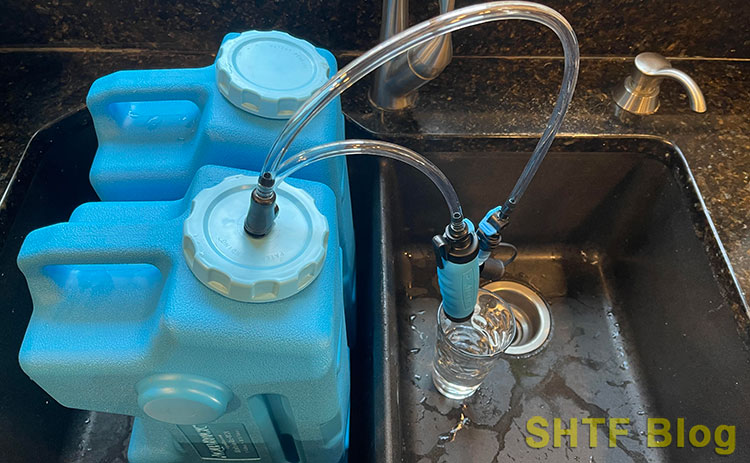
This system is also versatile. During normal times, we leave them stored with water, conveniently stacked on top of one another with their built-in stacking features.
We pull them out of storage in the summer to use them camping. I lay them on my truck’s tailgate, screw in the spigot, and use it like a faucet. In remote areas we can use the filtration system to filter water from a stream or pond.
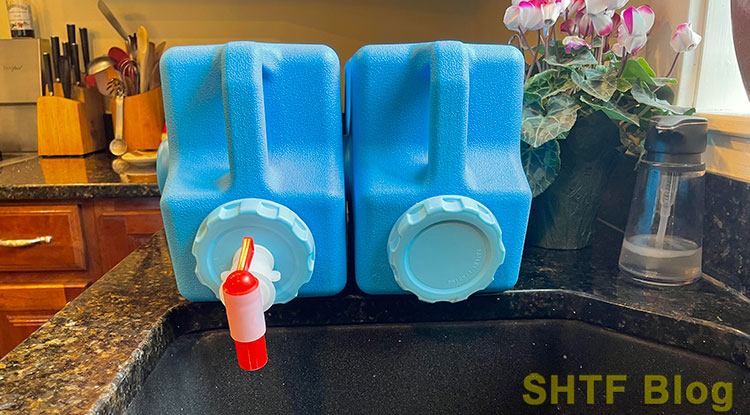
You can buy the AquaBrick storage containers and all of the accessories at Sagan Life. That’s where mine came from.
There are some great features to this system:
- It purifies water, capable of removing viruses
- Comes with a very portable, stackable water container
- Takes additional accessories (like a spigot)
- Great for both domestic and backcountry use (not backpacking)
- Made in the USA with a money back guarantee
Summary
There are plenty of water filters to use at home during a crisis, and some of them could double for backcountry use. However, if you are in a situation where you would have to pump out serious potable water (a family of four or more), you want a robust filter or purifier, something much more than the popular LifeStraw.
I think any of the aforementioned water filters should serve a family well. My personal overall favorites? The three I already own.
Care to share your thoughts? What do YOU use as a water filter for home use during an emergency? Something we missed? Let us know in the comments section.


